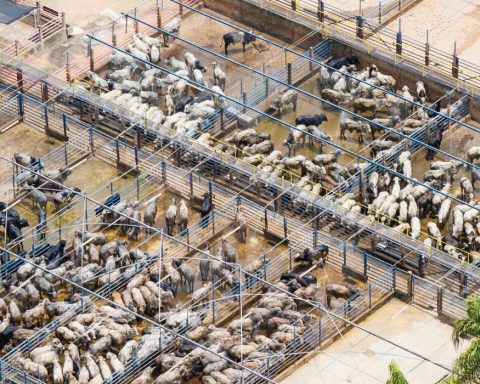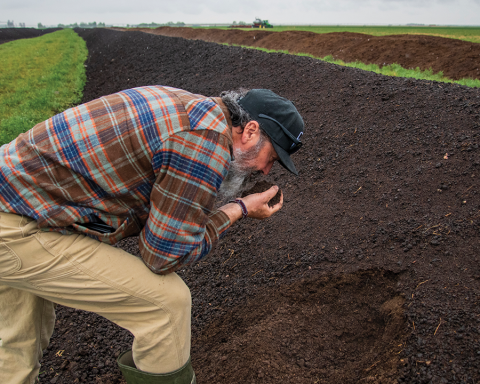From Tofino, B.C., to Yarmouth, Nova Scotia, people are grappling with the rising cost of food. A recent survey conducted by the University of Saskatchewan found that 31% of Canadians are eating less-healthy food due to inflation and that 5% had resorted to stealing food to survive. Food Banks Canada’s 2022 Hunger Count reports a 35% increase in visits since 2019. Sadly, 33% of food bank users are children, while 18% are single parents. During 2022, food prices increased by 10.4%.
Canada’s Food Price Report warns us that food price inflation will continue throughout 2023, especially for dairy, vegetables and meat, and that a family of four will need an additional $1,000 to feed themselves. This is not a short-term crisis. Many of the crop losses that caused prices to rise were caused by the increase in dramatic floods, droughts and storms, courtesy of the climate crisis, which is just getting started. Meanwhile, politicians on Parliament Hill held committee hearings last week to grill grocery-store CEOs on their part in the sky-high prices.
If you were minister of agriculture, what would you do? Websites are full of advice on how to shop more wisely, but this is not the way to address a food crisis.
- Form community food hubs
Most of the work needed to increase food security is local, requiring partnerships and planning. Every neighbourhood, county or town needs a community food hub to promote best practices and policies, taking inspiration from the Food Hub Network in British Columbia. Community food hubs are often community-led initiatives that distribute local food to those who need it. Governments could provide start-up grants to launch food hubs where they don’t yet exist.
Through strong partnerships, local governments can work with community organizations to turn vacant urban land into allotment gardens. Local farmers can benefit from the shared distribution systems of community networks; schools can develop year-round food gardens; residents can be encouraged to grow food on public boulevards; fruit-tree gleaning projects can be started; and much more.
In B.C., the provincial government has announced a $200-million investment to spend on a variety of measures to increase local food security and reduce the cost of food.
- Launch a nationwide grow-your-own-food campaign
Throughout history, people have dug into the soil to grow the food they needed. When hunger demanded it, they terraced entire mountainsides to create new beds. At Kiwi Cove outside Ladysmith, on Vancouver Island, 10 volunteers meet for three hours each Tuesday and Thursday morning from spring to fall to grow food for the Ladysmith Food Bank on a 4,750-square-metre plot of land. Together, they grow almost two tonnes of vegetables total, or 200 kilograms per volunteer, in a growing season. In Montreal, volunteers with Carrefour solidaire are growing vegetables in a plastic greenhouse in the middle of winter with thick snow on the ground outside, raising lettuces, cabbages, bok choy and many other vegetables.
We need a nationwide campaign to persuade Canadians to grow their own food, just as we did in wartime with victory gardens and like efforts launched by non-profits during the early months of the COVID-19 pandemic. A survey by the National Gardening Association showed that Americans could save more than US$500 a year by growing their own food. To encourage Canadians to grow their own food, the federal government could give a $500 grant to any group of five or more neighbours who help each other to convert their lawns into food gardens. In a city of a million people, the government could issue 1,000 grants that would cost $500,000, or $19 million for the entire nation.
To encourage more home-grown food, the government could also remove GST from gardening tools, equipment and bedding plants and set up a fund for garden clubs to help new food gardeners. If the government distributed the grants through community food hubs, this could accelerate the formation of hubs in communities where they don’t exist, as residents (having seen the benefits in other communities) would pressure their government to set them up.
- Protect farmland
In Ontario, 319 acres of high-grade agricultural land – equal in size to 58 city blocks – are lost to development every day, according to the Ontario Federation of Agriculture. Since the beginning of the pandemic, municipal zoning orders have been used six times in Ontario to rezone farmland for urban use. For sure, we need to build a massive amount of new housing, but there is more than enough land to build two million new homes in the Greater Golden Horseshoe area around Toronto by 2031, without touching the Greenbelt or expanding urban boundaries.
In British Columbia, good farmland has been protected since 1973 through the Agricultural Land Reserve, but 50% of it is sitting empty, not used for farming. In Surrey, B.C., research found that if 3,300 hectares were used for small-scale, human-intensive, direct market production, it could supply 100% of Surrey’s seasonal consumption of 29 crop and animal products, and create 1,500 jobs.
The solution is to tax unused farmland at an annually increasing rate, forcing owners to either start farming, lease the land to a farmer, or sell. This would reduce the market price of farmland and open up opportunities for new farmers. Metro Vancouver has explored various ways of making farmland tax changes, but nothing has happened.
- Save and distribute the food that’s wasted
Millions of Canadians are food insecure, yet 58% of the food produced in Canada each year is lost or wasted, according to Second Harvest, a food rescue organization. Of this, 32% (11.2 million tonnes) is edible food that could be redirected to support hungry Canadians. That’s 295 kilograms of dumped food per person per year, or 5.7 kilograms a week. We need to eat around 1.8 kilos of food a day, so that’s enough food for three days. Canada’s goal is to reduce the amount of food wasted by 50% by 2030.
France has set a goal to reduce its 5.5 million tonnes of food waste by 50% by 2025. In that country, 32% of food is lost during farming, 21% during food processing, 19% by consumers, 14% by grocery stores and 14% by restaurants. Since 2016, the French government has banned larger supermarkets from throwing away unsold food that could be donated to a charity. In return, they save on landfill fees and get a tax break of up to 60% on the value of the donated food.
But there are some holes in this plan. The French Federation of Food Banks found that every morning, 2,700 supermarkets send food that would otherwise be wasted to 80 warehouses, rescuing 46,000 tons a year. This, however, is just 6% of France’s grocery store food waste, and the system also assumes that struggling people will go to a food bank.
There’s a lot more that the supermarket industry could do, including training its staff and using demand planning to identify likely food waste. The online grocery store Spud offers imperfect produce at 50% of the price and donates what it can’t sell to charities. Since 2009, the non-profit Move For Hunger has delivered 32 million pounds to food banks across the United States and Canada, equivalent to more than 26 million meals, but that’s two million meals a year, or only 5,500 meals a day. And it still requires people to go to food banks. Across Canada, only 4% of the surplus edible food is being redistributed to charitable organizations. That means 96% is still being thrown away or turned into animal feed or biofuel.
In Italy, the city of Milan has launched three food-waste hubs. They look like regular grocery stores, but all the food is donated by local businesses and supermarkets, and families in need can use a prepaid card to buy what they need. Between them, the hubs recover 130 tonnes a year, around 260,000 meals, saving 30% of the city’s food waste.
An app from Too Good To Go, a certified B Corporation founded in Copenhagen, now in 17 countries (including Canada), seems very promising. It enables bakeries, grocery stores, restaurants and hotels to put surplus food in a bag, and consumers use an app to pre-pay for a bag at a third of the normal price. In Canada, it has saved 1.4 million meals through 5,000 partners, helped businesses to earn $5.5 million on food that would otherwise have gone to waste, and helped consumers to save $16.3 million on food they would otherwise have had to buy at full price. What would it take for every store to get on board?
- Promote and adopt a plant-based diet
There are many reasons why we should reduce our consumption of meat and dairy, chief of which is that the livestock industry accounts for 60% of agriculture’s greenhouse gas emissions, according to a University of Illinois paper. The reason for including it here is that meat is expensive, and a plant-based diet is a good way to reduce your grocery bills (as long as you avoid some of the more trendy plant-based brands).
One analysis found that the savings for a vegan are $4.50 a day, or $1,500 a year, entirely neutralizing the increased cost of food. A Harvard study put the saving at US$750 a year. Around 2.8 million Canadians describe themselves as primarily vegetarian, and 1.7 million as primarily vegan. That leaves 35 million Canadians who could be reducing their grocery bills by adopting a plant-based diet.
- Stop food profiteering
Canadians for Tax Fairness reports that Loblaws’s markup increased from 32.5% in 2010 to 46.7% in 2022, and profits rose by 10%. “If they had maintained their 2019 markup, that would have saved Canadians almost $900 million,” economist D.T. Cochrane told the Toronto Star. Loblaws has 27% of Canada’s grocery retail market, or some 10 million Canadians, so that’s $90 per customer – or $1.73 a week. The price of two tomatoes. Not exactly a crisis-solver.
Loblaws’s recent quarterly profits also rose by $529 million, which the company says stems from the growth of non-food sales (such as clothing, personal care products and financial services). But even if it came from increased food prices, it’s only a dollar a week for their 10 million customers: half a cucumber. Parliament held hearings last week into possible grocery store profiteering, but I suspect that this may be a red herring ($1.72 for a tiny 3.5-ounce can of herring) as the evidence seems to show that if they have been profiteering, it’s on a very small level.
On the other hand, a report by Oxfam International found that 62 food capitalists became billionaires during the pandemic, amid record profits for the industry titans, whose wealth increased by 42% while global food prices soared by 33%. A small handful of corporations, including Kraft Heinz, General Mills, Conagra, Unilever and Del Monte, control the market share of 80% of the food products we buy, so governments need to cooperate to take a close look at monopolistic collusion in the industry, to find ways to reduce it.
A new Greenpeace report found that globally, 20 of the world’s biggest food corporations reaped such big profits in 2021 and 2022 that they were able to return US$53.5 billion to their shareholders. The United Nations, meanwhile, has recently issued an urgent humanitarian appeal to raise US$51.5 billion to help 222 million people who face acute food insecurity, including 45 million who risk starvation. Something is very rotten in the state of global food capitalism.
Back here in Canada, those of us who can afford the increased cost of food may not be worried. So, remind yourself: almost one in three Canadians are eating less healthy food because of rising costs. If we are to continue to think of ourselves as a caring people, our ministers of agriculture must step up: this is the time for big moves.







